Key takeaways:
- Employment law is constantly evolving, highlighting the need for both employees and employers to stay informed about changes to avoid costly mistakes.
- Adapting workplace policies to reflect new legislation fosters employee trust and morale, while also enhancing a company’s competitive edge in attracting talent.
- Involving employees in policy review processes can lead to valuable insights and a sense of ownership, making the policies more effective and relevant.
- Measuring the impact of policy changes requires both qualitative and quantitative analyses to understand their emotional and practical effects on the workforce.

Overview of Employment Law News
Employment law is a dynamic landscape, constantly evolving to reflect the changing needs of society and the economy. I’ve always found it fascinating how new legislation can reshape workplace policies overnight. For instance, when the remote work trend surged during the pandemic, many organizations had to scramble to adapt their policies to ensure compliance with new labor laws. How many employers felt overwhelmed during that transition?
What strikes me is how crucial staying informed about these changes is for both employees and employers. I remember a client who faced a significant legal challenge simply because they weren’t aware of new regulations surrounding employee rights in remote settings. This situation underscores the importance of following news and updates in employment law, as ignorance can lead to costly mistakes.
Moreover, engaging with employment law news allows us to anticipate future trends. I often find myself wondering: what will the next big shift in legislation be? As I reflect on past changes, such as the push for greater workplace diversity and inclusion, I realize that being proactive not only safeguards against legal issues but can also foster a healthier work environment, benefiting everyone involved.
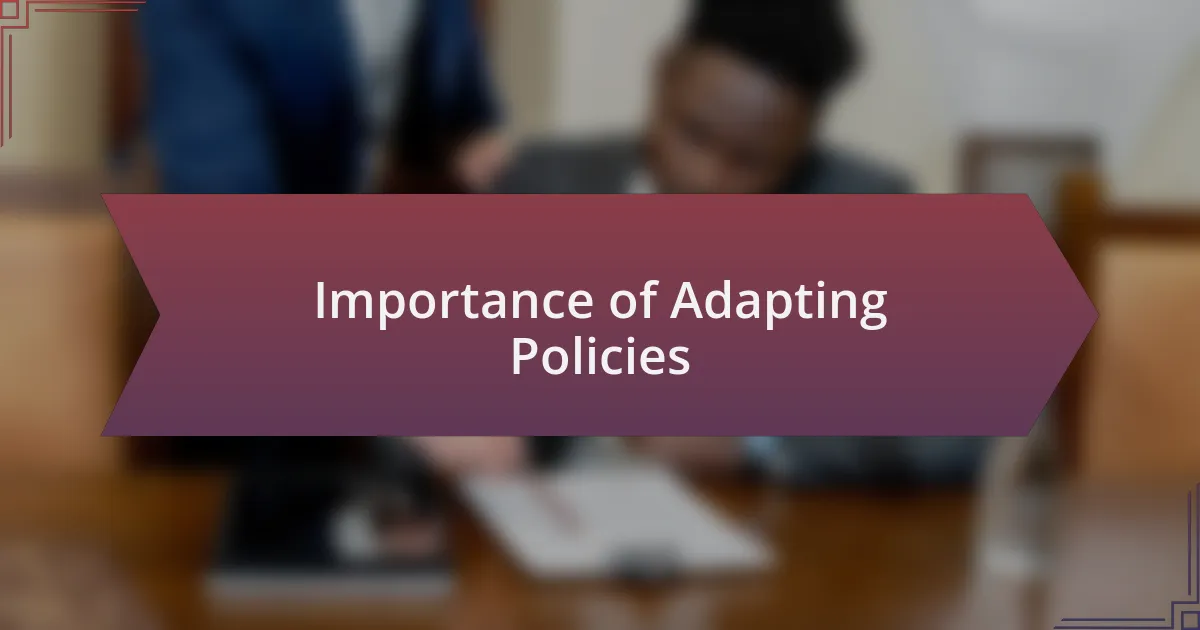
Importance of Adapting Policies
Adapting workplace policies to new legislation is not just a regulatory task; it’s a vital strategy for sustaining employee trust and morale. I once witnessed a company that hesitated to update its policy following a significant law change. The resultant discontent among employees was palpable; they felt uncertain about their rights and protections. Isn’t it essential for teams to feel secure in knowing their employer stands behind them in adherence to the latest laws?
When organizations embrace policy changes, they signal their commitment to a fair and compliant workplace. I recall a coaching session with a manager who had just overhauled their harassment policy to align with recent legislation. Their enthusiasm was contagious, as they recognized how this change could create a safer environment. This proactive approach not only mitigated potential legal risks but also fostered a culture of respect and accountability.
Furthermore, adapting policies allows businesses to remain competitive and attract top talent. I often reflect on conversations with HR peers who share how a modern, compliance-focused policy can set a company apart in the hiring market. This connection between legal adaptability and employee attraction is too significant to overlook. Why would anyone want to work for an organization that appears outdated or unaware of its legal obligations? By evolving with the law, companies can enhance their brand image alongside their bottom line.
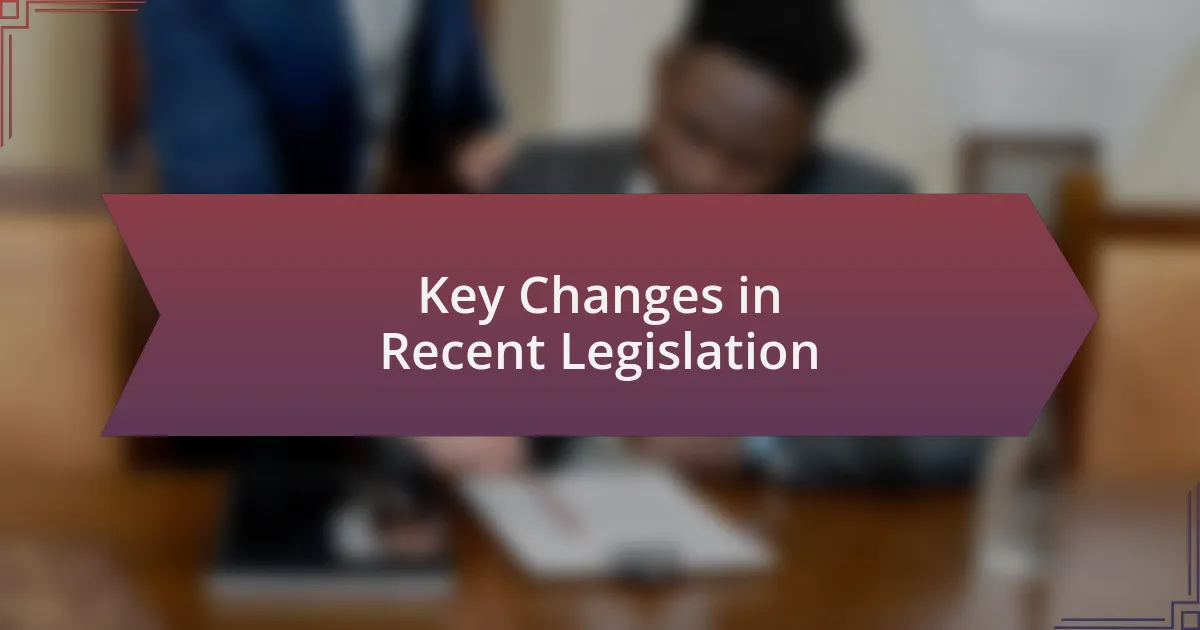
Key Changes in Recent Legislation
Key Changes in Recent Legislation
Recently, there have been significant modifications regarding employee classification, particularly in who qualifies for overtime pay. I remember discussing this with an HR colleague who was scrambling to adjust their payroll systems to comply with these changes. It’s a reminder that staying informed is crucial; without proper adaptations, companies risk financial penalties and diminished employee satisfaction.
Additionally, the introduction of paid family leave has transformed how businesses approach employee support. I had a poignant conversation with a manager who implemented this policy in their workplace. They shared how offering this benefit not only boosted morale but also led to a noticeable reduction in employee turnover. Isn’t it fascinating how supportive measures can create a ripple effect in workplace culture?
Finally, the recent emphasis on remote work protections is reshaping our work environments. I often reflect on a webinar I attended that focused on these new regulations and how they require thoughtful policy revisions. These changes not only honor the evolving landscape of work but also empower employees to connect with their organization more meaningfully. How can organizations truly thrive if they don’t adapt to the shifting dynamics of the workforce?
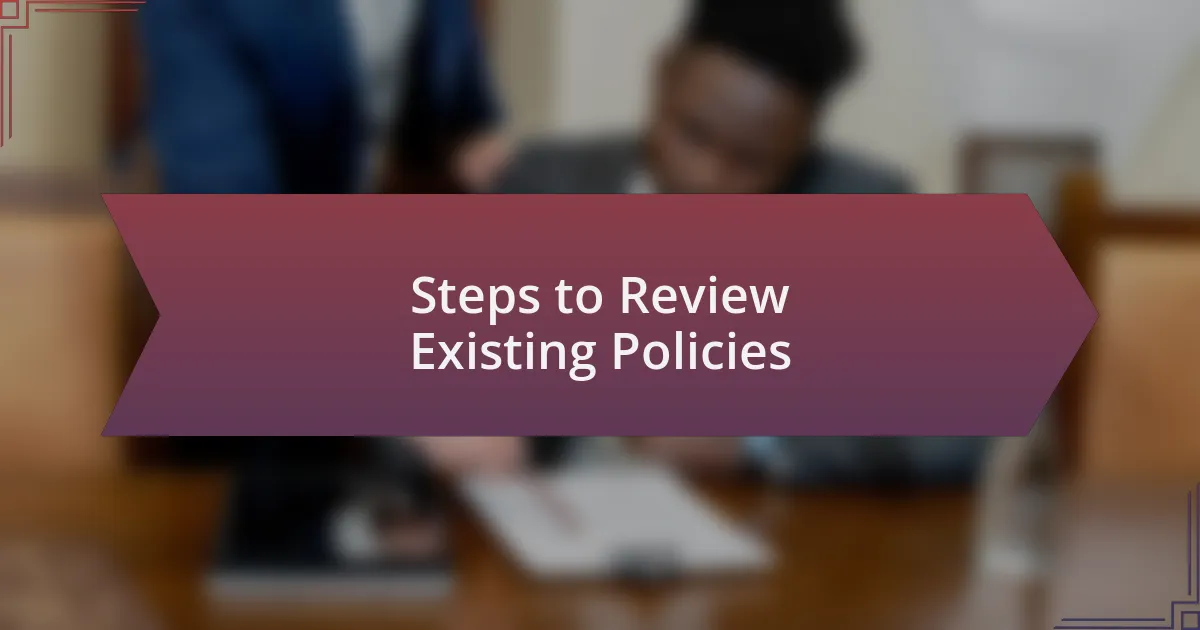
Steps to Review Existing Policies
To effectively review existing policies, I recommend starting with a comprehensive assessment of current documents. I once conducted a thorough policy audit at my previous job, and it was eye-opening. We discovered several outdated provisions that no longer aligned with the company’s values or legal requirements. Have you ever stumbled upon a policy that felt like it belonged to a different era? It can be quite a revelation.
Next, gather feedback from employees across various departments. In my experience, frontline staff often have invaluable insights about how policies play out in real-world scenarios. I remember organizing focus groups where employees shared their thoughts on the effectiveness of our leave policies. It was encouraging to see how their input not only led to practical improvements but also fostered a sense of ownership in the policy-making process. Why not empower your workforce by involving them in these crucial discussions?
Finally, ensure that any identified gaps or issues are addressed through clear, actionable changes. I once worked on updating a remote work policy after realizing it failed to accommodate the unique challenges our team faced. The transformation not only clarified expectations but also improved overall productivity and morale. Are your policies ready for these types of meaningful updates? Taking that step can make all the difference in creating a supportive, compliant workplace.

Strategies for Policy Adaptation
One effective strategy I often use for policy adaptation is to create a timeline for implementation. In my last role, we faced significant changes in labor laws, and I found that having a phased approach helped alleviate anxiety among staff. By breaking down adjustments into manageable steps, employees felt more prepared and engaged with the changes. Have you ever felt overwhelmed by sweeping updates? A gradual rollout can truly ease that transition and foster acceptance.
Another strategy is to ensure that communication remains fluid throughout the adaptation process. When I first introduced new health and safety policies, I hosted informal Q&A sessions where team members could express concerns and ask questions. The feedback was invaluable; it allowed me to refine our approach, making everyone feel heard. Aren’t those moments when we connect truly powerful? Keeping the dialogue open can transform policy changes from mere announcements into collaborative efforts.
Lastly, consider the role of ongoing training and support. I remember implementing digital tools to assist with compliance tracking, but I quickly realized the importance of comprehensive training sessions. Initially, the team struggled with the new software, but after investing time in focused workshops, their confidence soared. Isn’t it amazing how knowledge can empower us? Providing robust training can ensure that policies are not just pieces of paper but lived practices in the workplace.
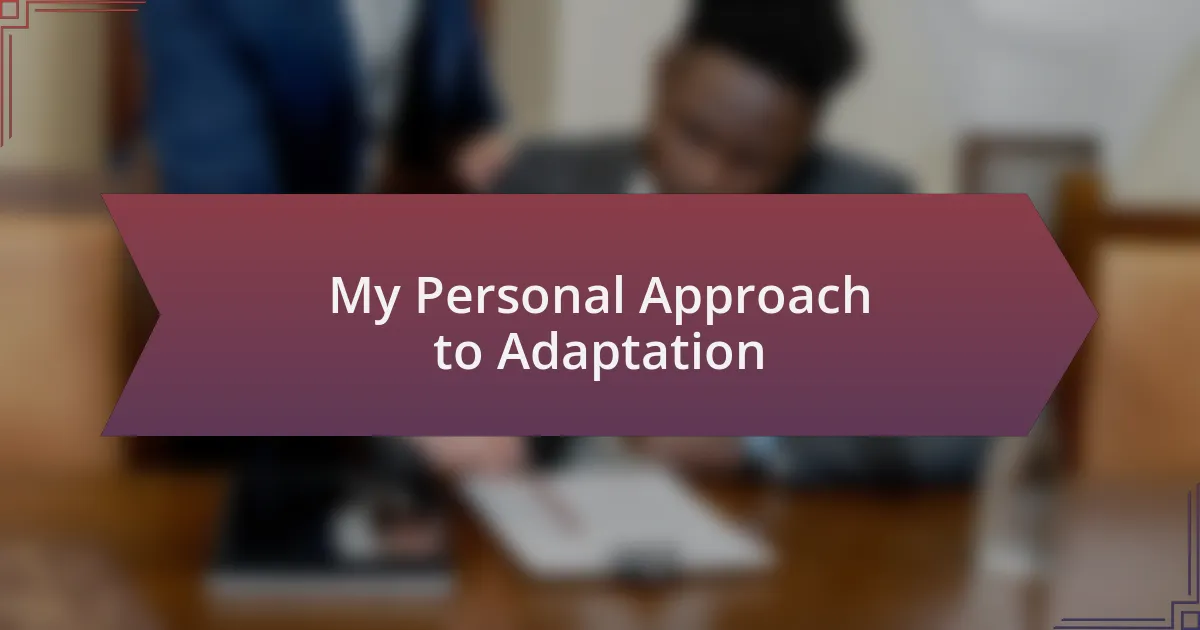
My Personal Approach to Adaptation
My personal approach to adaptation revolves around being proactive rather than reactive. For instance, when faced with new family leave policies, I chose to engage my team in brainstorming sessions early on. I wanted their input to shape our implementation plan, and I discovered that involving them not only generated creative solutions but also built a sense of ownership. Have you noticed how collaboration can spark enthusiasm and commitment?
I often reflect on the power of empathy in the adaptation process. When I navigated changes surrounding remote work policies, I understood that many employees were juggling personal and professional challenges. I took the time to consider their circumstances, reaching out one-on-one to show my support. By fostering an environment of understanding, I saw teammates become more adaptable, open to discussing hurdles and potential solutions. Don’t you think that a little compassion can go a long way in easing transitions?
Finally, I’ve learned the importance of continuous feedback loops. After implementing new compliance measures, I set up an anonymous survey to gauge employee sentiments. Surprisingly, it revealed areas I hadn’t considered and prompted adjustments we hadn’t initially planned for. Isn’t it fascinating how much insight we can gain by simply listening? This practice not only improves policies but also cultivates a culture of trust, where staff feel their voices matter and contribute to the organization’s growth.
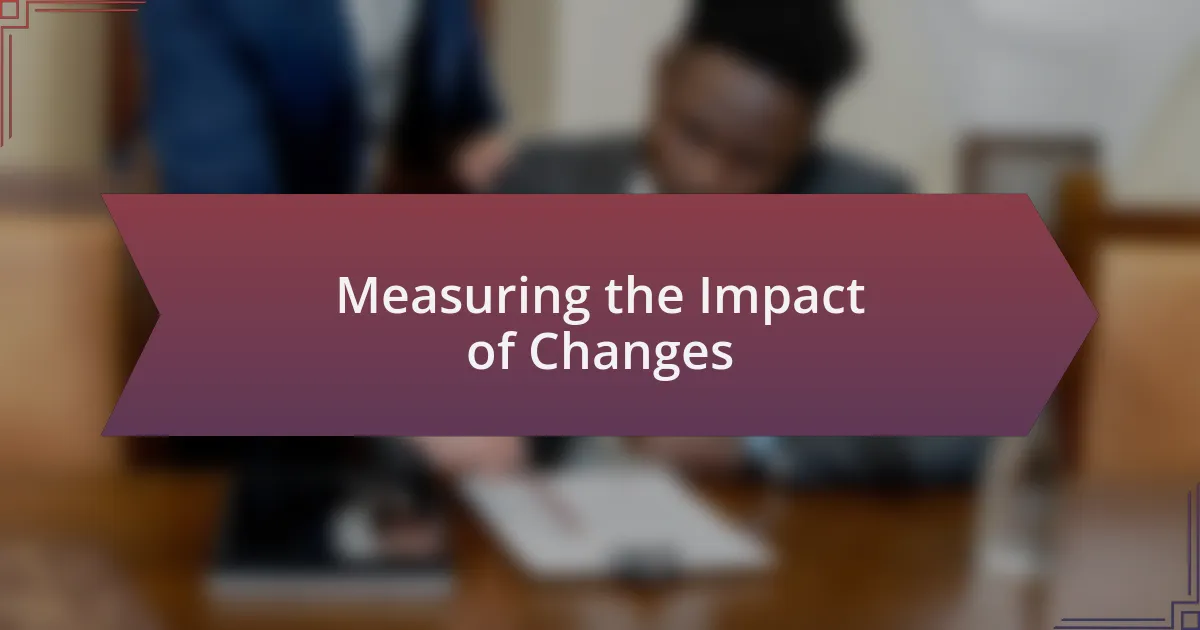
Measuring the Impact of Changes
Measuring the impact of changes requires more than just checking boxes; it demands a thoughtful analysis of both qualitative and quantitative data. For instance, when I implemented a new flexible working arrangement, I didn’t just look at productivity metrics. I hosted informal coffee chats to get a sense of how the team felt about the transition. Those conversations revealed that morale actually increased, which wasn’t something I anticipated. Doesn’t it make you wonder how often we overlook the emotional side of policies?
Taking a deeper dive into metrics is crucial as well. I previously tracked the number of requests for remote work versus traditional office hours. Surprisingly, the data highlighted a significant preference for remote work, emphasizing the need for adjustments in our policy framework. It struck me how important it is to align our practices with actual employee behavior. Have you ever considered how numbers can tell stories that emotions reinforce?
Lastly, I find it essential to benchmark against industry standards. When I realized our turnover rates were marginally above the industry average after a policy change, it prompted me to investigate further. I reached out to peers in similar roles and learned they were experiencing the same challenges. This collaboration not only affirmed that I wasn’t alone but also sparked ideas on how to adapt more effectively. Isn’t it interesting how sharing experiences can illuminate paths to improvement?